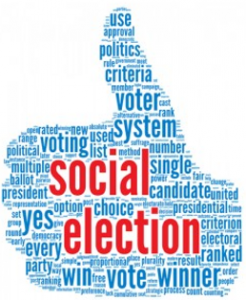
Image Credit: Impact Media
This year, no one can argue that social media marketing – primarily Twitter and Facebook – has played a significant role in this year’s Presidential Election. According to the Pew Research Center, the level of social media activity by 2016 candidates is higher than during the 2012 presidential campaign. This could be due to the millennial generation, known for their social media savvy, making up 35 percent of the voting population.
Social media marketing has become an integral part of both Hillary Clinton and Donald Trump’s campaign but much of the response has been dark, perpetuating very slanted and narrow views of the election. Never before have potential voters been able to connect, share and express their opinion with like-minded individuals. The down side is that many people are focusing on the bad, creating a sometimes ugly social media universe.
Social Media is the Political Glue that Ties and Empowers Your Opinion
Many of the people who follow both Hillary Clinton and Donald Trump on social media see the daily cycle of campaign through fragmented and highly curated windows, but it’s often the supporters and influencers who shape perceptions, according to whatever views serve their preferred candidate’s interests. Even though social media allows people to be exposed and find a wide variety of political opinions and viewpoints, research has shown that people tend to pick and seek out like-minded individuals who share their narrow interest. Many of these voters are looking for confirmation that their opinions are correct and rarely do they seek out multiple stances or beliefs.
Social Media Can Mirror and Amplify Ugly Behavior

Image Credit: Forbes
Since social media has become a tool and a way of expressing one’s position and attitude towards particular opponents or propositions, much of what researchers have found is that this form of marketing has had a great influence on the psychological and sociological parts of the voter.
Still considered the wild west of current marketing practices, social media’s usage is still being developed daily; therefore, many people haven’t learned to be civilized while using these platforms. Since there is no sort of checks and balances, social media has become a way to impose one’s attitude in ways that are much more hurtful than helpful, explains Brian Solis, a principal analyst at research firm Altimeter Group.
Social Media Through a Scripted Lens
Much of what you see on social media is a direct reaction to content seen or heard through traditional media outlets. Many of these social media sites have become a medium for reactionary content, as opposed to “informative”, with many political strategists seeking out segmented audience in order to feed them information in a way that is specialized to the interest of whichever candidate or issue they are promoting. While older generations still seek out traditional news sources for information on the issues, most people 18 to 29 years old say social media is the most helpful source of information.
There is no question that social media marketing has played an important cultural role in this year’s Presidential Election, and overall, people who follow the candidates on social media see the weekly cycle of the campaign through a series of narrow channels. What was once a new age method of campaign marketing, social media has now fallen into a murky sphere of name-calling, bullying and uninformed messaging. We won’t know its true affects on the electorate until after November 8th, but one thing is for certain, much like this campaign, social media needs to clean up its act before 2017.
Like this post? Check out past blogs in the archive below.
